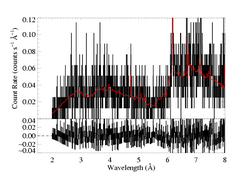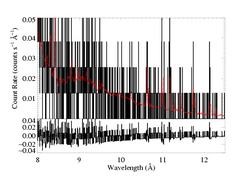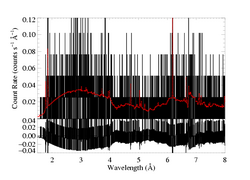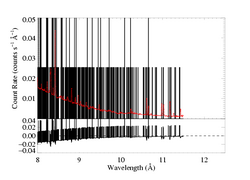Global fits
Analysis of the flare portion of the observation
The interval from 54 ks to 70 ks of the observation is analyzed here. Note that we have now excluded the rise-time (48 to 54 ks).
2-temperature thermal model with non-solar abundances
We use the same bapec (bapec + bapec)*wabs model we used to analyze the total observation's spectrum. We fit the MEG (top two panels below) and HEG (bottom two) simultaneously, and plot the best-fit model on the data, with the fit residuals shown below. For clarity, we break both the MEG and HEG spectra into two sections. The axis ranges are the same for the pairs of plots, and also the same we used for the total observation, to facilitate fair comparisons. Note that "+/-" uncertainties are actually 68% confidence ranges for the specified parameters.
The fit is formally good, using chi squared with Churazov weighting. And it looks pretty good, both in the lines and the continuum (though there may be a few weak lines at short wavelength that are under-predicted by the model; however, the S/N is so poor that it's hard to tell for sure). The flux level is about twice as high as for the observation as a whole (the y-axis limits are the same here as for those plots). More relevant is the comparison to the pre-flare spectrum. The flare spectrum shown here is stronger (flux is ~3 times higher) and harder, though the difference is mostly in the hotter component, which is more than twice as hot as in the pre-flare data, and has a normalization almost twice as big.
Compare these results also to those from the post-flare section of the observation.
Back to the main page.
last modified: 12 April 2009



